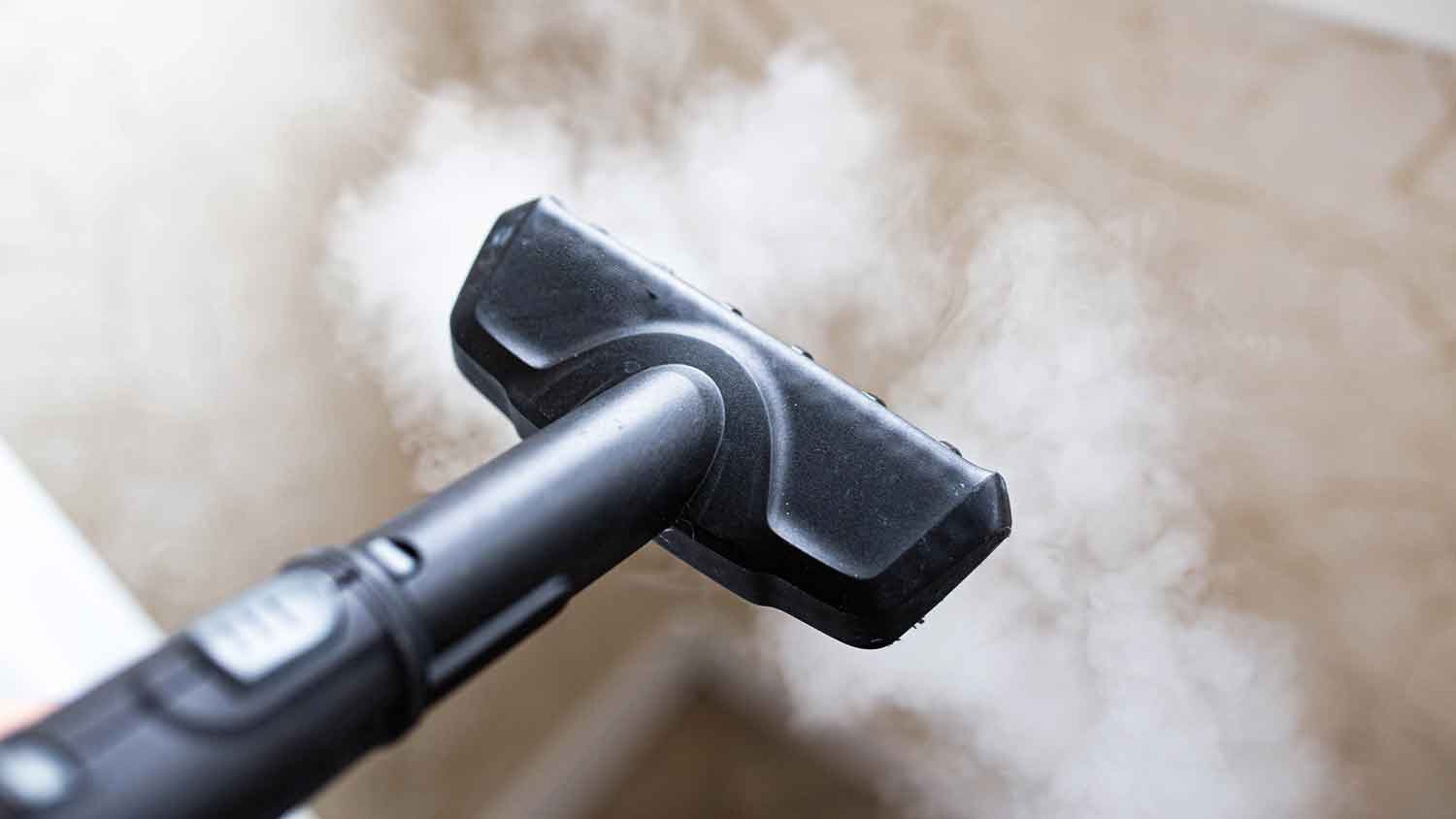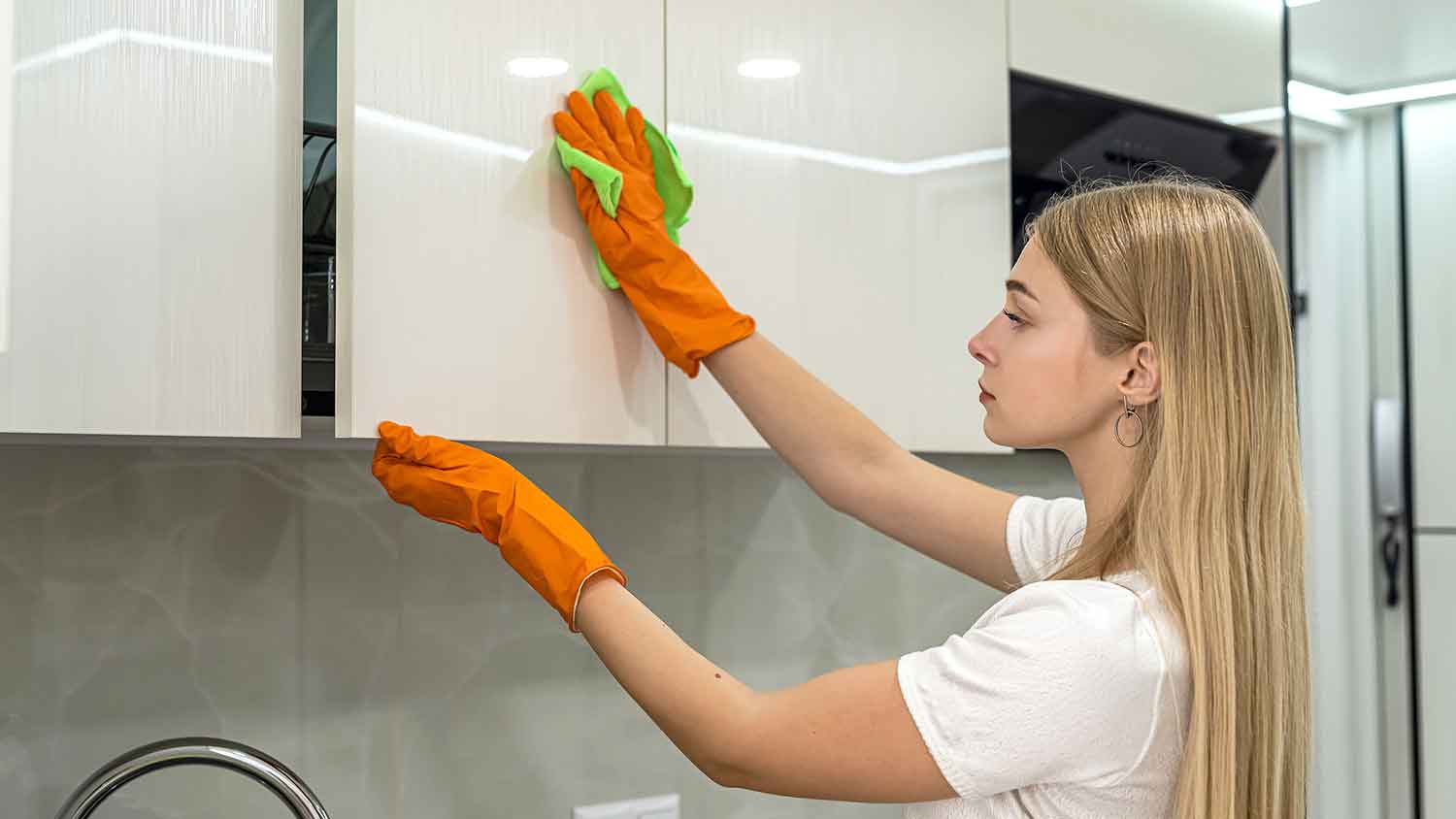
Tile and grout cleaning brings your tiled rooms back to life. In this guide, find out the details of how much it costs to hire tile and grout cleaners.
The answer depends on the material


You can steam clean kitchen cabinets exclusively made from sealed hardwood.
Do not steam clean cabinets made from unsealed wood, plywood, medium-density fiberboard, or laminate—it will damage the cabinet material.
Keep your cabinets clean using everyday pantry items like dish soap, vinegar, and baking soda.
Well-maintained kitchen cabinets can last for 50 years, which is why it’s worth investing in a regular steam clean service.
Your kitchen cabinets are exposed to many different substances, from dust and dirt to grease and food stains. This can make it hard to keep them clean. If you have a steam cleaner, you might wonder, “Can you steam clean kitchen cabinets?” The exact answer depends on your cabinet material. We’ve broken down when to use a steam cleaner on your cabinets and when to avoid this cleaning method.

Steam cleaners can safely be used on sealed wood kitchen cabinets. To deep clean your cabinets, follow these steps:
Empty your cabinets and wipe them down with a damp cloth.
Plug in the steam cleaner and let it heat up to the medium setting.
Attach a nozzle to the steam cleaner.
Starting from the top of your cabinets, slowly work your way down, loosening dirt with the steam as you go.
Wipe the cabinets with a microfiber cloth to remove the dirt as the steam loosens it.
Repeat the process on any remaining dirt, using a soft brush attachment to work the dirt loose.
You can use the steam cleaner on both the inside and the outside of kitchen cabinets as long as they are made from sealed wood.
Kitchen cabinets made from unsealed wood, plywood, medium-density fiberboard (MDF), or laminate should never be cleaned with a steam cleaner. Steam can warp these materials and cause permanent damage.
This is because plywood, laminate, and MDF are made from several layers of material. When exposed to steam or humidity, the layers can start to separate, warping over time. The cabinets' life span will be shorter, and you’ll need to spring for replacements sooner rather than later. Installing new kitchen cabinets costs between $2,010 and $11,060, or an average of $6,385.
A professional cleaning service near you can help keep your cabinets clean using the right cleaning equipment and supplies. Alternatively, you can look into ways to clean your cabinets without using steam to help prolong their life.

If you can’t use steam on your kitchen cabinets, there are other ways to keep them looking spotless.
Dusting: Run a lint-free duster over your kitchen cabinets a few times each week to remove grime and prevent excessive buildup.
Soap and water: A simple solution of 1 tablespoon of dish soap mixed with 1 quart of warm water can clean your cabinets so they look new. Wet a clean cloth in the solution, then wring it out and wipe down the cabinets and handles. Finish by wiping down the cabinets with a cloth soaked in clean water to remove the soap residue, then dry with a clean cloth.
Vinegar and water: Mix 1 cup of white vinegar and 2 cups of warm water to eliminate grease from your kitchen cabinets. Soak a cloth in the mixture, wring it out, and then wipe down the cabinets. Wipe stubborn grease stains with undiluted white vinegar on a cloth. Rinse with warm water and dry thoroughly.
Vinegar and baking soda: Combine 1 tablespoon each of baking soda and vinegar to make a paste. Apply the paste to stains on your kitchen cabinets using a clean, damp cloth and let it sit for a few minutes. Scrub with a soft-bristle brush or a washcloth, then rinse with clean water and dry.
When properly cared for, kitchen cabinets can last up to 50 years. Follow these tips to keep your cabinets looking as good as new for longer.
Check the manufacturer’s instructions to determine how to clean your cabinets best.
Avoid using abrasive cleaners, which can damage your cabinets.
Avoid products that contain alcohol, ammonia, bleach, or polishes, as they can damage the finish.
Test a small, inconspicuous area of your cabinet with your steam cleaner before cleaning the entire surface.
Avoid using steam if you’re unsure what material your cabinets are made from.
Wipe up spills immediately to prevent staining or other damage.
If your cabinets are damaged, you can reface them or replace them entirely. The cost of kitchen cabinet refacing is an average of $7,230, though the total could be as little as $4,240 or as much as $10,220, depending on the material and the project scope. Refacing involves replacing the cabinet doors and drawer fronts while keeping the interior cabinet boxes. Cabinet refinishing costs less at an average of $3,120. It involves stripping, cleaning, sanding, and painting or staining your cabinet fronts to give them new life.
It went very well. Mark was punctual, courteous and went straight to work. Installations were clean and professionally done!
He did a great job He was prompt and did a clean job!
"I work various hours and I needed someone to organize my place for me; such as cleaning and doing my laundry. "Michele" came over and cleaned my place in a jiffy! She is my regular assistant, and thanks to her I feel more confident.
The electrician was very courteous, did his work efficiently and even cleaned up after himself.
Retired our entire phone system, clean work, quick service, great price, would recommend highly to anyone!
I just moved to St. George and purchased a home. I hired HiCaliber to clean my carpets throughout the whole house. They did the best job I have ever seen a carpet cleaning service do. I have had the carpets cleaned in the past in my other house but results were not even close to the job of...
Green Elite has always answered my calls for home cleaning whenever I need it. The attention to detail they have is great. They always leave my home spotless, clean and fresh, which is why I have grown to love them. Their management is top-notch and it is the main reason why I never had any...
From average costs to expert advice, get all the answers you need to get your job done.

Tile and grout cleaning brings your tiled rooms back to life. In this guide, find out the details of how much it costs to hire tile and grout cleaners.

Planning ahead helps ensure an efficient, budget-friendly move. Learn how much move-out cleaning services cost based on factors like home type and size.

Garage clean-out costs vary considerably depending on the garage size, the waste type and amount, and how much work you do yourself.

If clutter is slowly taking over your home, it’s time to consider hiring a pro. Learn how to hire someone to declutter your home so you can relax once more.

Figuring out how to clean stainless steel sink hard water stains doesn’t have to feel like playing connect-the-dots. Here are five easy ways—and even more tips.

Follow this guide to learn when and how to steam clean walls in your home. When the wall surface is suitable, it’s an easy, chemical-free way to sanitize.